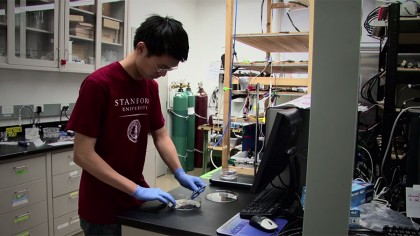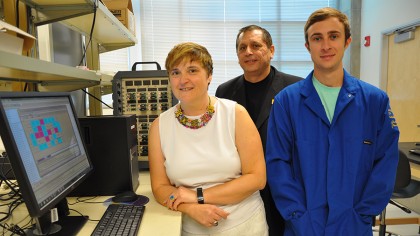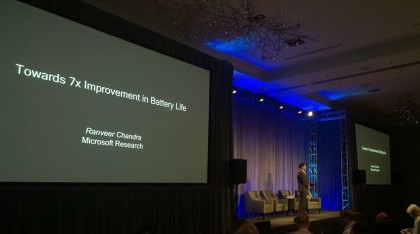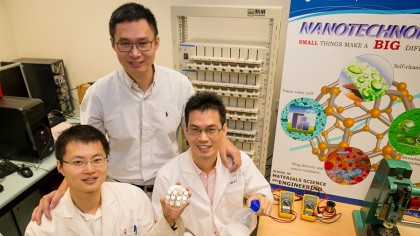The past, present and future of smartphone batteries
Will our mobiles ever last more than a day?
Battery technology is a complex science, so you're unlikely to see any breakthrough battery projects appear completely out of nowhere.
Any progress that's made in the field has to be rigorously tested and examined before it can get close to our smartphones, and making sure it works and is safe is only part of the equation – it also needs to be commercially viable too.
Most of the papers and press releases you'll read about battery breakthroughs involve some kind of chemical tweak to get more energy out of the same battery over a longer time. These small improvements don't attract the same kind of headlines as flexible phone screens or a new smartwatch, but they're much more important for the future of our electronic gadgets.
Amprius is one of the companies working on the problem, and it has the backing of some top-level investors too (not least Google Chairman Eric Schmidt).
It started in Stanford University and received $30m in funding last year. The batteries Amprius is developing can store 50% more energy than today's blocks thanks to the use of silicon in the anode.

The founder of Amprius is Stanford professor Dr. Yi Cui, who is something of a celebrity in the field of battery research. We spoke to Wesley Guangyuan Zheng, one of the researchers working in Dr. Cui's lab, about what's around the corner.
"To overcome the physical limitation of current battery technology, we need to look for alternative battery chemistries that will have higher theoretical value," he told us. "Some of the new materials that have been explored include silicon and lithium metal for the anodes, and sulfur for the cathodes. These materials can potentially offer three-to-five times increase energy density as compared to today's lithium-ion batteries."
Get daily insight, inspiration and deals in your inbox
Sign up for breaking news, reviews, opinion, top tech deals, and more.
"These materials each have their own issues and problems. For example, silicon and lithium metal experience large volumetric expansion during battery cycling and that causes degradation of the electrode integrity. Scientists have come up with many innovative solutions to the problem, and we are seeing some of these technologies getting out into the market, albeit at a small volume."
Despite the complex nature of the science involved, and plenty of promising theories that have had to be abandoned, there is hope for the future. "There are many groups around the world, including our lab at Stanford, working on these advanced electrodes," says Zheng.
"The landscape will depend on the breakthroughs in battery material development. At the same time, battery companies are also making improvements on the current lithium-ion battery technology. Therefore, we are going to see much cheaper and better batteries down the road."
A longer-lasting battery and a cheaper smartphone to boot? Sounds perfect.

Also working hard on potential battery improvements are academics at the University of California, Riverside. "With current developments in our laboratories, we are able to fabricate novel materials by engineering them at the nanometer scale – 100 times thinner than human hair – which can be used as active electrodes in li-ion rechargeable batteries," Professor Mihri Ozkanor of the UCR Department of Electrical Engineering explains to us.
Professor Ozkanor told us that her work could eventually boost battery lifespans, shorten charging times and reduce the size of battery packs. "Highly cost-effective and scalable starting materials such as our paper-like silicon material could improve the existing battery technology, and the advancement in new electrode materials such as ours, will change the existing landscape of batteries in our cell phones and in other portable electronics," she says.
Last year one of UCR's most interesting innovations was to use sand to extend battery life by two or three times, but the common refrain applies again: the technology is still in its infancy, and a lot more research is required.
Sakti3 is another battery research company that has hit the headlines recently, thanks to a $15m investment from James Dyson.
The secret sauce the startup uses hasn't been explained in detail, but there are claims it can double the life of current smartphone batteries by essentially replacing some of the liquid chemical mix inside a battery with a solid-state equivalent that's said to be much more effective.
By using solid-state technology some of the dangers (like battery explosions) are removed, and the batteries can be made thinner and lighter too. Whether or not Sakti3 can get any further towards the consumer market than its predecessors have done remains to be seen, but the investment from Dyson will certainly help.
Finding the balance
Even when scientists make improvements in one area of battery design, it may be limited or negated by another aspect of the technology, which is why progress can seem very slow. It's akin to upgrading one part of your PC only to find a different component then becomes the bottleneck in the system.
For these various reasons efficiency savings in software and the electronics of our smartphones are likely to significantly extend battery life before there's any substantial improvement in the composition of the batteries themselves.
Microsoft has a different approach altogether. Its research team has floated the idea of splitting the smartphone battery in two, optimising one piece to provide quick bursts of power, and the other to keep your phone ticking over while it's not doing very much.

Microsoft Researcher Ranveer Chandra says that battery life improvements of 20-50% could be possible according to initial tests, but – and stop me if you've heard this one before – there's no estimate of when this might actually appear in a handset on the high street.
If you read up on the latest battery breakthrough news on the web, as we have for this article, you'll find a familiar pattern developing; most articles start with a declaration that a new discovery could make a huge difference to smartphone battery life, and end with an admission that more research and experimentation is required.
That's not to dismiss the valiant efforts of the scientists working on the puzzle – it just gives you some idea of the size of the task. You're not going to see an amazing new battery developed by a group of friends in a garage, for example.

Researchers from Nanyang Technological University in Singapore have been busy, too: their new and improved batteries use a titanium dioxide gel for the anode instead of graphite.
However, the improvements will largely be in how fast the batteries can charge and how many charging cycles they can withstand, rather than how long they can last between charges.
There are several alternatives to lithium-ion in development too, and it's possible that a different type of battery technology is going to power the smartphones of the future.
Right now though, there's a lot that's up in the air – and to explain each technology in turn would take ten feature-length articles rather than just one.
One of the technologies most likely to impact the market in the short-term is the use of lithium-sulfur batteries. They can – in theory – hold a lot more energy than lithium-ion batteries, but the challenge here is stopping them from degrading rapidly over successive charges.
The reality of the matter is that we're all still going to be charging our smartphones every night, for the next year or two at least. Take heart, though, because there are many people across the world working on the challenge of keeping our mobiles powered up for longer, and they are making progress.

Dave is a freelance tech journalist who has been writing about gadgets, apps and the web for more than two decades. Based out of Stockport, England, on TechRadar you'll find him covering news, features and reviews, particularly for phones, tablets and wearables. Working to ensure our breaking news coverage is the best in the business over weekends, David also has bylines at Gizmodo, T3, PopSci and a few other places besides, as well as being many years editing the likes of PC Explorer and The Hardware Handbook.